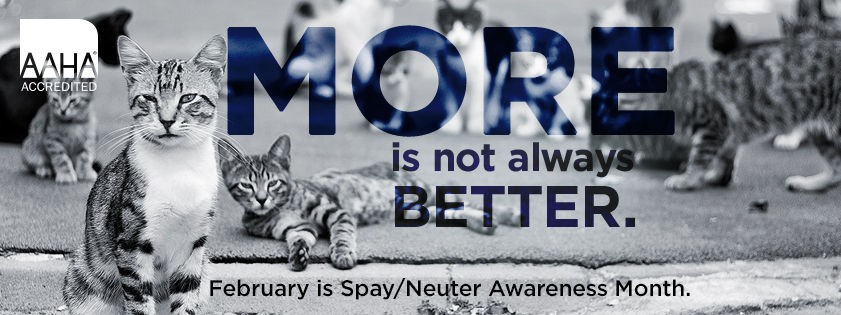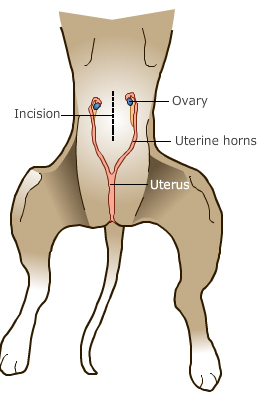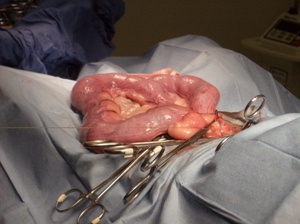
Spaying refers to the surgical procedure performed on female dogs and cats to render them infertile. There are many benefits to spaying your female companion. First, you will contribute to the prevention of the dog and cat overpopulation. Second, spaying will eliminate the sometimes ‘messy’ heat cycles that attract male dogs to your house from miles away. Third, you will help prevent diseases in your pet such as pyometra (infection in the uterus) and mammary cancer. Spaying involves surgical removal of both ovaries and the uterus (ovariohysterectomy). It can be performed under a number of anesthetics and monitoring devices. If you are shopping around for a competitive price on this procedure, be sure to question the pre-anesthetic blood screening, the type of anesthetic used and the monitoring equipment and procedures followed. We use several monitoring devices during your pet’s anesthetic. A registered veterinary technologist continually assesses your pet’s vital signs during the procedure. Although the risk of an anesthetic death in a normal healthy pet is very rare, our monitoring devices and procedures allow us to respond to an anesthetic emergency faster. Faster responses can save lives. Click here for Surgery Options we offer our patients.
Please call or visit our facility to learn more about our spaying procedures. Click here for interactive presentation on Importance of Spaying and Neutering Your Pet
The Many Benefits of Spaying Pets
Spaying is the term commonly used for an “ovariohysterectomy”, the surgical removal of the entire reproductive system including the uterus and ovaries. (The term neuter applies to both sexes and can be used to denote spaying in females and castration in males)
Spaying removes many of the problems associated with pregnancies. Spaying is still the only safe and reliable method of birth control in both dogs and cats. With humane societies and animals shelters overwhelmed with homeless and abandoned animals, spaying is an important way in which we can be responsible pet owners and not contribute to the problem of pet overpopulation.
Spaying a pet will ensure that the problems associated with heat cycles are avoided. For example, in dogs, the bloody discharge from the vulva, which can persist for two to three weeks during each heat period, can result in bloodstains around the house. This problem is further complicated by the fact that they must be kept indoors or be closely supervised when outdoors to prevent the unwelcome approaches of males. In cats, the excessive vocalization and behaviour associated with heats is also avoided if spaying is done. If not mated, female dogs may also experience “false pregnancy”, a condition wherein they behave as if pregnant, complete with whining, restlessness and lactation even though no pregnancy has occurred.
Female dogs run an increased risk of life-threatening medical problems later on in life if they are not spayed. For example, there is an alarmingly high risk of contracting uterus infections in older females that are not neutered. These infections are often life threatening and in many cases the treatment of choice is surgical removal of the uterus.
Spaying a dog before its first heat greatly reduces the risk of mammary tumours. Studies have shown that the chances of getting breast cancer in female dogs increases significantly with each successive heat period until the age of two years. After two years of age, spaying does not really make any difference on the incidence of breast cancer, although there are still all the other benefits associated with spaying. This is one very good reason why it is not necessary to have a litter or heat in order to develop your pet’s personality.
There are some things that spaying will not do. Spaying will not make a pet fat or lazy. It will decrease their metabolic rate and definitely lowers their caloric requirements so you have to just feed them much less which is a real cost saving benefit. Obesity in pets is usually the result of overeating and a lack of exercise. Similarly, spaying does not change a pet’s personality or temperament, whether for good or for bad. Spaying is a very safe surgical procedure. Many owners delay the operation because of a concern for their pet’s well being (i.e. aesthetic and/or surgical risks). These concerns should be discussed with your veterinarian.
Spaying a dog with huge pus filled uterus are shown in the two pictures below -Pyometra this life threatening condition is very common in older dogs that have not been spayed. It is a costly and dangerous disease that can be prevented.



